Algorab, Delta Corvi (δ Crv), is a white subgiant star located in the constellation Corvus. With an apparent magnitude of 2.962, it is the third brightest star in Corvus, after Gienah and Kraz. It marks the right wing of the celestial crow. Algorab lies at a distance of 86.9 light years from Earth. It is one of the four bright stars that form an asterism known as Spica’s Spanker.
Star type
Algorab is a white subgiant of the spectral type A0 IV(n) kB9. It has a mass about 2.74 times that of the Sun and, with a surface temperature of 10,400 K, it is about 69 times more luminous than our star. Algorab is a fast spinner, with a projected rotational velocity of 236 km/s.
The star’s age is uncertain, with estimates of both 260 million years and 3.2 million years. The latter would indicate a pre-main sequence star, one that has blown away its surrounding envelope of dust and gas but has not yet fully condensed and started burning hydrogen in its core. Even though it is usually classified as a subgiant, the star’s evolutionary status is uncertain and Algorab may in fact be a much younger star.
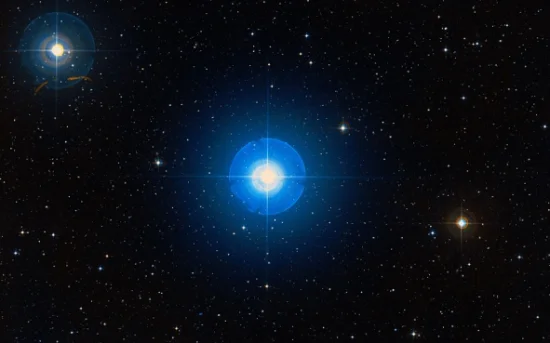
Algorab (Delta Corvi), image: Wikisky
Algorab has a companion, but it is uncertain whether or not the two stars are physically related. The companion, HR 4757 B, is an orange main sequence star of the spectral type K2Ve. It has an apparent magnitude of 9.3 and is separated by 24.2 arcseconds from Algorab. The two stars share a common proper motion, but HR 4757 B is believed to be much younger. It is a post-T Tauri star, which is to say it is not a newly formed star, but it has not yet settled on the main sequence either. The physical separation between the stars is at least 650 astronomical units, which would give them an orbital period of 9,400 or more years.
Facts
Algorab and its neighbours Gienah (Gamma Corvi), Kraz (Beta Corvi) and Minkar (Epsilon Corvi) form an asterism known as Spica’s Spanker. Named after a type of sail, the asterism can be used to find Spica. A line drawn from Gienah through Algorab points the way to Virgo’s luminary.
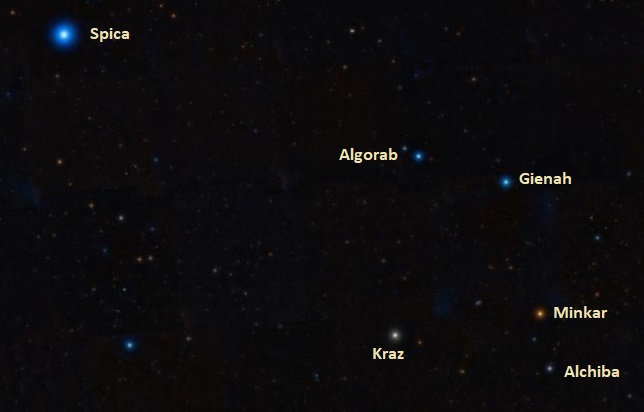
Spica’s Spanker, image: Wikisky
In medieval astrology, Algorab was one of the 15 Behenian fixed stars, which were considered useful in magical applications and believed to influence planets when they passed near them. Each of these stars was associated with a plant and gemstone that would be used in rituals to draw the star’s influence. Algorab was linked with the planets Mars and Saturn. Its plant was burdock and its gemstone, onyx.
Name
The name Algorab (pronunciation: /ˈælɡəræb/) comes from the Arabic al-ghuraab, meaning “the crow.” It is a reference to the constellation Corvus, which represents the celestial crow or raven. The name comes from the phrase al-janāħ al-ghirāb al-yaman, meaning “the right wing of the crow.” The name of Algorab’s brighter neighbour Gienah is derived from the same phrase, even though Gienah marks the left wing of Corvus on modern star charts.
The name Algorab was approved by the International Astronomical Union’s (IAU) Working Group on Star Names (WGSN) on July 20, 2016. It formally applies only to the component Delta Corvi A.
The Chinese know Algorab as 軫宿三 (Zhěn Sù sān), the Third Star of Chariot. The Chariot asterism is formed by the same stars that form Spica’s Spanker in western astronomy: Gienah, Kraz, Algorab and Minkar. In Chinese astronomy, the asterism is one of the southern mansions of the Vermilion Bird.
Location
Algorab is easy to find because it is part of a recognizable asterism, Spica’s Spanker, that lies near Spica, one of the brightest stars in the sky. Spica can be found using the stars of the Big Dipper’s handle: Alkaid, Mizar and Alioth. A curved line extended from the Dipper’s handle first leads to the bright Arcturus in the constellation Boötes and then to Spica.
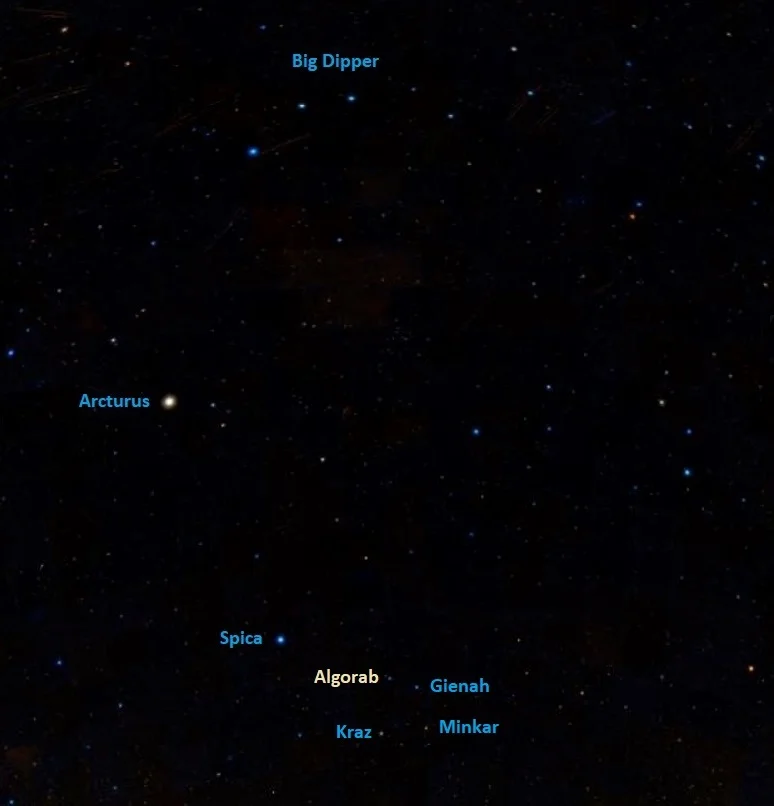
Algorab location, image: Wikisky
Spica’s Spanker is found just southwest of the star. Algorab sits at the northeast (top left) corner of the asterism and is the nearest of the four stars to Spica.
Algorab can be used to find the famous Sombrero Galaxy. Also known as Messier 104, the Sombrero is a bright, large unbarred spiral galaxy located 29.3 million light years away in the constellation Virgo, near the border with Corvus. It appears 5.5 degrees east of Eta Corvi, a fainter white star that appears in the same field of view as Algorab. The Sombrero Galaxy has an apparent magnitude of 8.0 and can easily be seen in smaller telescopes.
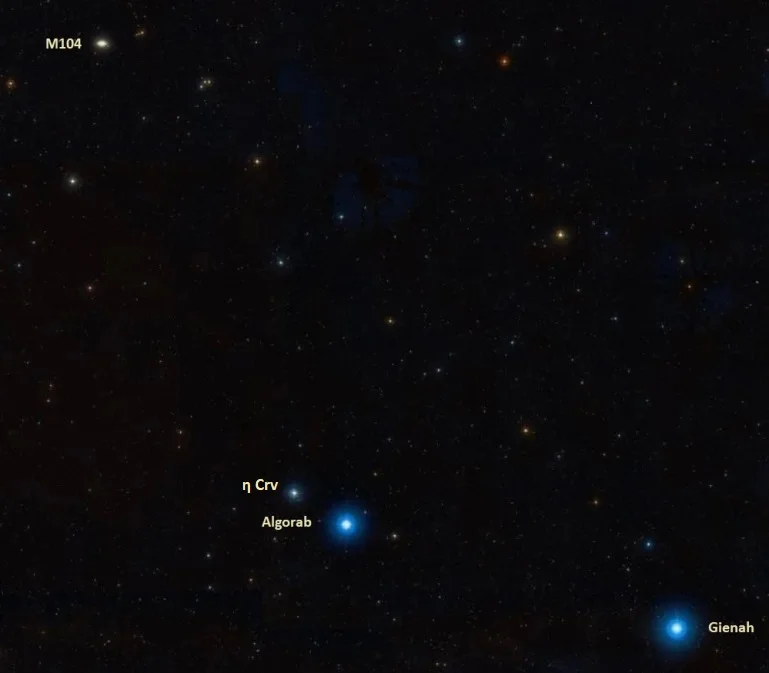
Algorab and the Sombrero Galaxy (M104), image: Wikisky
Constellation
Algorab is located in the constellation Corvus. Representing the sacred bird of Apollo in Greek mythology, Corvus is one of the Greek constellations, first listed by the Greek astronomer Claudius Ptolemy in his Almagest in the 2nd century CE.
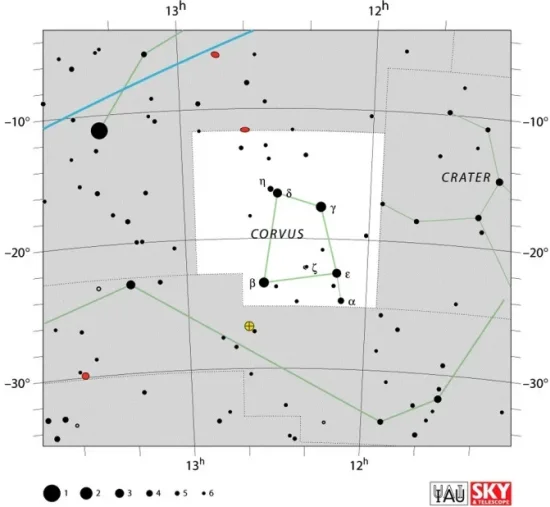
Corvus constellation map by IAU and Sky&Telescope magazine
Corvus occupies only 184 square degrees of the southern sky and is the 70th constellation in size out of 88. It is easily recognized since its brightest stars form a quadrilateral pattern known as Spica’s Spanker. Of the 29 visible stars in Corvus, only three are brighter than magnitude 3.00, making the constellation relatively inconspicuous and hard to see from light-polluted areas.
Corvus is known for being home to the famous Antennae Galaxies (NGC 4038 and NGC 4039), a colliding pair just west of Spica’s Spanker that lies at the centre of the NGC 4038 Group. The NGC 4038 Group also contains the elliptical galaxy NGC 4033, the spiral galaxies NGC 4027 and NGC 3981, and a dozen or more other galaxies. Corvus also hosts a relatively bright planetary nebula, designated NGC 4361. The nebula has a visual magnitude of 10.9.
Interesting stars in the constellation include the blue giant Gienah, the yellow bright giant Kraz, the orange giant Minkar, the white main sequence star Eta Corvi, which has two debris disks, and the variable stars VV Corvi and SX Corvi, both of which are eclipsing binary systems.
The best time of year to observe the stars and deep sky objects in Corvus is during the month of May, when the constellation rises high above the horizon in the evening. The entire constellation is visible from locations between the latitudes 60° N and 90° S.
The 10 brightest stars in Corvus are Gienah (Gamma Crv, mag. 2.585), Kraz (Beta Crv, mag. 2.647), Algorab (Delta Crv, mag. 2.962), Epsilon Corvi (mag. 3.024), Alchiba (Alpha Crv, mag. 4.03), Eta Corvi (mag. 4.29 – 4.32), HD 107418 (mag. 5.14), VV Corvi (mag. 5.19 – 5-34), TY Corvi (31 Crt, mag. 5.19 – 5.23), and Zeta Corvi (mag. 5.21).
Algorab – Delta Corvi
| Spectral class | A0 IV(n) kB9 |
| U-B colour index | −0.050 |
| B-V colour index | −0.045 |
| Apparent magnitude | 2.962 |
| Absolute magnitude | 0.2 |
| Distance | 86.9 ± 0.4 light years (26.6 ± 0.1 parsecs) |
| Parallax | 37.55 ± 0.16 mas |
| Radial velocity | 13.90 ± 2.3 km/s |
| Proper motion | RA: −210.49 ± 0.14 mas/yr |
| Dec.: −138.74 ± 0.08 mas/yr | |
| Mass | 2.74 M☉ (2.68 – 2.81 M☉) |
| Luminosity | 69.0 L☉ (60.1 – 78.7 L☉) |
| Temperature | 10,400 K |
| Age | 260 million years (236 – 274 million years) or 3.2 million years (3.1 – 3.3 million years) |
| Rotational velocity | 236 km/s |
| Surface gravity | 4.06 ± 0.05 cgs |
| Constellation | Corvus |
| Right ascension | 12h 29m 51.8551642s |
| Declination | −16° 30′ 55.552542″ |
| Names and designations | Algorab, Delta Corvi, δ Crv, 7 Corvi, HD 108767, HR 4757, HIP 60965, FK5 465, SAO 157323, BD−15 3482, LTT 4742, NLTT 30918, GC 17029, GCRV 7515, JP11 2224, IRAS 12272-1614, 2MASS J12295187-1630552, PLX 2880.00, PPM 225920, UBV 11226, TYC 6103-2395-1, Gaia DR2 3520586071216143488, ADS 8572 A, CCDM J12299-1631A, IDS 12247-1558 A, WDS J12299-1631A |